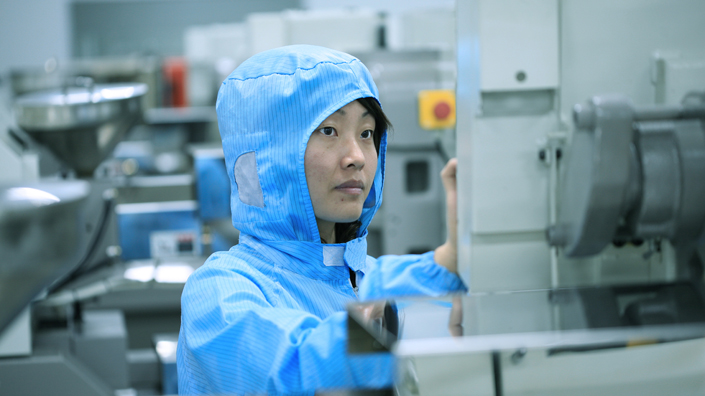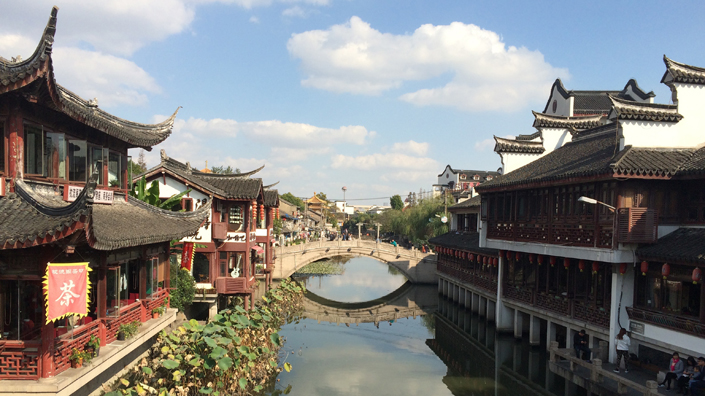The golden lion smiles broadly, its traditional Chinese and Buddhist nature in stark contrast to the sleek, mirror-windowed skyscraper that towers over it. One worshipper after another in the magnificent Jing’an Temple in central Shanghai kneels down next to a huge fuming cauldron and says a prayer. They may be bankers or other workers who came here during a lunch break on a Friday afternoon, perhaps from one of the thousands of offices along the street, or tourists from elsewhere in China.
Welcome to Shanghai, the country’s buzzing financial, commercial and transport hub, where modern ways and deep-rooted traditions co-exist, but don’t jar with one another. The whole fabric of the city is a web of ancient customs and modern technology.
Shanghai isn’t a smart city, at least not in the sense that we’ve come to understand the term. There is no visible smart parking, I didn’t notice any autonomous or connected cars on the roads, and there were no intelligent street lamps or internet-connected rubbish collecting trucks. The famous Maglev train is already 13 years old and doesn’t surprise anyone (although many tourists still bypass going into Shanghai by taxi just so they can be magnetically levitated for the whole of eight minutes on the way from Pudong airport into the city).

The maglev train (Credit: Katia Moskvitch)
But what is new is the rapid but discreet digitalisation that takes place inside the enterprises based in this megalopolis, as well as other major Chinese cities. In March 2015, the Chinese government announced its intention to move the country to Industry 4.0, eyeing innovation with the aim of making manufacturing smarter and much more digital.
Why? Simple: to transform the country into a manufacturing powerhouse. Not much longer is China likely to be the place of low-end, low-wage and low added-value production. It’s the end of the Era of Copycats, says Qi Wu, vice-chairman of consulting company Accenture in Greater China.
This decade-long Made in China 2025 initiative is starting to bear fruit. The most traditional industries such as steel making and railways are beginning to adopt new technologies to improve the training of their employees, as well as the communication and transparency with their customers.
Many are installing more high-end robots on production lines, in a bid to boost productivity and open new markets in the West. According to estimates by research group the Conference Board, by 2018 China’s contribution to global GDP will surpass that of the US.
“China is where manufacturing is reinventing its future,” said Zhang Ying, China managing director of French technology company Dassault Systèmes. He was speaking at a recent conference run by Dassault in Shanghai, with the rather cryptic-sounding title Manufacturing in the Age of Experience – until you see the names of the company’s product range.
Digital shop floors
Change will be especially visible beyond 2030, when China is likely to transform into a new product-service oriented economy, says Wu. “The future economy is all about pulling instead of pushing towards customers,” he says. And it’s also about co-operation with the West – something Western companies also need to understand, he adds.
Ying points at telecoms group Huawei as a firm rapidly turning to digital methods, transforming its manufacturing with the help of Dassault Systèmes’ 3D software, the 3DExperience. It allows companies to create a virtual factory – in order to digitise their whole production cycle.
It’s not just about simulation in 3D, when digital twins can be created in real time, and using different parameters to test various scenarios where faults might occur – in the way police use predictive analytics to anticipate hotspots for crime. It’s also a platform that allows the entire enterprise, from the chief executive to every single worker, to log into the system and visualise the shop floor, to communicate, brainstorm collaboratively, report faults in real time, and back-up everything in the cloud.

More and more companies in China are embracing connectivity and Industry 4.0 (Credit: iStock)
“Cloud technology is the most important technology,” says Fred He, vice-president of global ecosystem and business development at Huawei Technologies. “We are a big country and still have big problems with a low level of automation at small and medium-size enterprises, and fragmented desire to upgrade their technology. We think that cloud technology is the only way out for these small firms.”
Huawei has 180,000 employees globally and 3,000 partner companies in the manufacturing sector alone. Digitalisation helps the firm to keep tabs on quality not only at its own operations but also to make sure that its partners manufacture products on its behalf to the same standard, says He. “Different streams have different requirements for the cloud, so we have to be aware that different stages of growth are very important. It’s all about automation, digitalisation and intelligentisation.”
It’s not just Huawei – other companies such as China’s major steel manufacturer Tangsteel and train builder CRRC Tangshan are now using intelligent digital platforms to improve teamwork and customer relations and boost productivity.
Services and AI
Or take Siemens, which isn’t just thinking about creating higher-speed trains, but also about the promise of bringing punctuality to the market, says Wu. “And a more digitalised railway station creates other experiences, such as perhaps convincing more passengers to take their trains,” he adds. “It’s not just about speed any more. Many Chinese manufacturers need to improve operational efficiency, create new business models, new experiences and new services. That’s key.
“Soon, smart products will look like a smart toolbox similar to an iPhone – before it reaches the consumer, the product will be complete with gadget apps to generate new value for the customers,” says Wu. In the near future, “the business model will undertake a shift to a model where we will focus on efficiency”.
And it’s not just about getting traditional behemoths to become tech-savvy. In Shanghai the government wants to create the country’s hub for artificial intelligence (AI) and innovation. According to estimates by China’s State Council, the value of the country’s AI industries will exceed 150bn yuan (US$22.15bn) by 2020 and 400bn yuan by 2025.
Shanghai is already home to more than a third of China’s AI professionals. The city itself is arguably a great testing ground for big-data-related work; it runs several major databases with more than 300m pieces of information on Shanghai’s 25m-plus citizens and 1.8m local companies.

Shanghai (Credit: Katia Moskvitch)
Under the AI project, the state wants to build high-tech industrial zones in the Xuhui and Pudong districts of the city. In Xuhui, the idea is to create an ‘Intelligence Valley’ covering a million square metres along the Huangpu River. Speaking at the 2017 Global (Shanghai) Artificial Intelligence Innovation Summit, the city’s vice-mayor Zhou Bo said smaller industrial parks would focus on robots, autonomous cars, big data and cloud computing and were set to be built in Jing’an, Yangpu, Jiading and Baoshan.
The project has already taken off: a recently completed 200-metre-high skyscraper on Longyao Road, the AI Tower, will be a global AI development and exhibition centre.
And work is under way on a 1-million-square-metre AI town in the Beiyang area, where companies will work on technologies such as driverless cars and facial recognition.
Getting industries on board
But Wu cautions that pouring money into AI and getting the best experts concentrated in one place won’t do the whole job. The main challenge, he says, is to get industries to actually apply AI – just as they are slowly starting to embrace digitalisation of their shop floors using the latest simulation software such as Dassault Systèmes’ 3DExperience digital platform.
Not everyone is digitally advanced, though. Out of 174 Chinese companies with various degrees of efficiency success that Accenture has analysed, only 4% were embracing digitalisation. “There are many other leading companies in China that are not that advanced in digital application,” says Wu, adding that it didn’t mean they were not successful. But, he says, looking into the future, everyone must understand that smart manufacturing is key.
One of the biggest challenges for Chinese manufacturing companies is to understand the invisible value of digitalisation, says Tony Tan, a partner at management consultancy McKinsey. It used to be “relatively easy” to spot gaps between China and developed economies, he says, and relatively simple to identify solutions to bridge them.
“But now we are entering into a new phase and some of the problems can’t be easily solved by introduction of individual tools,” he adds.
For instance, to resolve city traffic jams, he says, it’s no longer traditional industries or the government that are tackling the problem; instead, you will find start-ups with young management teams under 30 leading the change. Chinese firms must anticipate any disruptive companies coming into their industry, because “once they emerge, you’ll be given very little time to react. You need to approach the market proactively, use big data, and consider your time to market,” he says.
And it’s not so much about competing directly with Western countries as working together with them, says Wu. “It’s more about how to leverage the potential benefits of the size of the consumer market in China to try the future growth even on the global level.
“To quote Abraham Lincoln, the best way to predict the future is to create the future,” he adds. “That’s what Chinese companies must do to succeed.
“As entrepreneurs, as leaders, they must learn to approach the world from a different angle.”
Content published by Professional Engineering does not necessarily represent the views of the Institution of Mechanical Engineers.